The Latest News from PA Chapter of APA…
Planning for parks, open space, recreation, natural resources, and historic preservation is one of the most rewarding areas for planners, partially because this type of planning clearly falls into the realm of government action, and partially because the results are so apparent to all and appreciated by everyone. This month, read about a leader in recreation planning, an award-winning greenway plan, a phenomenal community park, and a great federal resource on the Delaware River. Enjoy!
Educational Opportunities
 The next Webinar Wednesday, So You Want to Build a Trail: Tips for Planning, Design, Funding and Construction is scheduled for August 4, 2021 from 12:00 PM to 1:00 PM. Multi-use trails have seen a surge in popularity because of the COVID-19 pandemic, and are increasingly being used for transportation, in addition to their traditional role as a recreational amenity. The objective of this session is for planners to understand how they can help local governments and nonprofit organizations plan for and implement trail projects. Deadline to register is August 3rd.
The next Webinar Wednesday, So You Want to Build a Trail: Tips for Planning, Design, Funding and Construction is scheduled for August 4, 2021 from 12:00 PM to 1:00 PM. Multi-use trails have seen a surge in popularity because of the COVID-19 pandemic, and are increasingly being used for transportation, in addition to their traditional role as a recreational amenity. The objective of this session is for planners to understand how they can help local governments and nonprofit organizations plan for and implement trail projects. Deadline to register is August 3rd.
If you are interested in sponsoring a Webinar Wednesday session or have a session for Webinar Wednesday, please contact us. Send your request to info@planningpa.org.
More Educational Opportunities:
- Penn State Extension presents Making Buffers Work for Your Community, Clients, and Residents, August 18. More information is available online.
- TCRPC presents PennDOT Connects Municipal Support Program, August 25. More information is available online.
Annual Conference
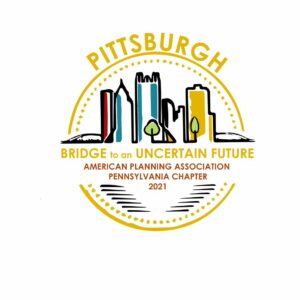 The 2021 APA PA Annual Conference, Planning for an Uncertain Future, will be held IN-PERSON on October 17-19, 2021 at the Sheraton Pittsburgh Hotel at Station Square. Conference announcement will be available later this summer. Here is a tentative conference schedule.
The 2021 APA PA Annual Conference, Planning for an Uncertain Future, will be held IN-PERSON on October 17-19, 2021 at the Sheraton Pittsburgh Hotel at Station Square. Conference announcement will be available later this summer. Here is a tentative conference schedule.
You can book your hotel room. The chapter only has a certain number of rooms in our block and once it’s full, IT’S FULL so don’t wait…book now.
We invite you to support the conference by sponsoring, exhibiting or advertising. The conference provides a unique and effective opportunity to showcase your work and capabilities to planning professionals and policy makers from across the Commonwealth. It’s also one of the ways to support planning in Pennsylvania by providing valuable networking, education, and development for planners. A big thank you to our sponsors, exhibitors and advertisers so far!
Community Planning Assistance Program Steering Committee
The APA PA Board is looking for volunteers to serve on the Community Planning Assistance Program Steering Committee. For more information please contact Amy McKinney (724-656-2193).
Opportunities for Giving
Each year the Chapter offers a scholarship to support individuals seeking funds for academic degree programs, internships, and professional development activities. If anyone would like to contribute to the Chapter’s Scholarship fund, donations can be made here. We accept all major credit cards, or you can send a check. Please make your check payable to “PA Chapter of APA Scholarship Fund” and mail it to P.O. Box 4680, Harrisburg PA 17111.
Key Open Space Partner: Diane Kripas of PA DCNR
Introduction
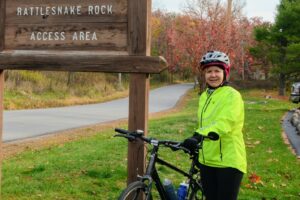 Diane Kripas just hit 30 years with the PA Department of Conservation and Natural Resources’ Bureau of Recreation and Conservation. She’s had many roles with the Bureau. She served as a regional recreation advisor, worked with county planners to develop their first greenway and trail plans, created the Bureau’s peer and circuit rider programs, and in recent years led the development and implementation of Pennsylvania’s Outdoor Recreation Plan. Currently, she is the Division Chief for the Bureau’s Partnership Division, where her motto is, “We never work alone.” Her division supports programs that cross boundaries: heritage areas, conservation landscapes, rivers conservation, trails and greenways, and regional recreation initiatives. Diane is a graduate of Hood College and Temple University and volunteers as Events Chair for the Capital Area Greenbelt Association.
Diane Kripas just hit 30 years with the PA Department of Conservation and Natural Resources’ Bureau of Recreation and Conservation. She’s had many roles with the Bureau. She served as a regional recreation advisor, worked with county planners to develop their first greenway and trail plans, created the Bureau’s peer and circuit rider programs, and in recent years led the development and implementation of Pennsylvania’s Outdoor Recreation Plan. Currently, she is the Division Chief for the Bureau’s Partnership Division, where her motto is, “We never work alone.” Her division supports programs that cross boundaries: heritage areas, conservation landscapes, rivers conservation, trails and greenways, and regional recreation initiatives. Diane is a graduate of Hood College and Temple University and volunteers as Events Chair for the Capital Area Greenbelt Association.
How is planning important in the field of parks and recreation?
In 1988 when I started with the Bureau, our storage room shelves were filled with parks and recreation plans, likely the first plan for most municipalities. The Bureau has encouraged and supported planning for over 50 years. The early plans were often general. In the 1990s, when railroads were abandoning rights-of-way, we began funding rail trail feasibility studies. Rail trails were a new type of trail, fraught with ownership complexities, connected by bridges requiring costly rehab, and often faced with opposition from neighbors. Nevertheless, almost all of Pennsylvania’s 2,000 miles of rail trails started with a plan.
In the 2000s, “greenways” was another new concept. We spent years explaining the concept of a greenway. Until, with the support of county planners, DCNR helped develop county greenway and open space plans in 65 counties. I haven’t been asked, “what is a greenway” in years. A plan helps educate on new ideas, and with public input, builds support and provides a roadmap on implementation.
I also advocate that if everything is a priority, nothing is. A plan helps prioritize capital projects and prepare for new trends like pickleball, loop trails, and nature play areas. Today’s planning is more specialized, and DCNR encourages wider public input and a focus on access for all.
What is a project you have worked on of which you are particularly proud?
I am most proud of developing a ½ mile trail spur that connects the Capital Area Greenbelt to my neighborhood. I live in the closest neighborhood to Susquehanna Township’s largest community park, which was only accessible by car for decades. It took over 20 years to get a trail easement and work with the Township to build the trail connection. The landowner was elderly and lived in a care facility out of state. When she passed away, the Township was finally able to negotiate an easement with her estate, applied for and received $50,000 in County gaming funds, and constructed the trail with Greenbelt volunteers. Now, my family and neighbors have safe, easy access to the 20-mile Greenbelt. You will find me there either walking, biking, or birding in my free time. I have cared for 20 blue boxes along the Greenbelt for a decade and am the proud mom of over 300 bluebirds.
Can you describe a typical workday in your position?
Summer is DCNR’s grant decision time. My staff review trail, river conservation, and partnership applications. In all, we discuss 150 projects and distribute about $17 million in grant funds. Every project is reviewed and scored by two staff and vetted through an extensive decision-making process. I also coordinate the implementation of the 2020 Recreation Plan, so there are lots of committee and sub-committee meetings.
What are the current trends you see in Parks and Recreation?
- Access to a great park within a 10-minute walk for all: We have a new 2020-2024 PA Outdoor Recreation Plan that casts a vision for Pennsylvania’s outdoor recreation: Enjoyable outdoor recreation is welcoming to all and accessible in every Pennsylvania community. Pennsylvania communities have built extensive park systems – over 6,100 local parks –, but less than half of Pennsylvanians can safely walk to a park within 10 minutes of home. We need to do more to ensure that all Pennsylvanians, regardless of race, age, ability, or any other trait, have access to and feel welcome at Pennsylvania’s public lands.
- Bring trails home: One comment summed up public input for the Recreation Plan: “increase the distance and number of walking, biking, and running trails connecting communities so outdoor recreation can be an integral part of daily life.” We need to continue efforts to make it easier for people to make healthy choices – walk to the trail vs. having to drive. Developing community/regional trail systems will continue to be a high priority for recreation facility investment over the next five years.
- Rise of water-based recreation: In the Recreation Plan, public survey respondents were asked to provide one outdoor recreation activity they currently do not do but would like to try. The most common response was kayaking. The PA Fish and Boat Commission reported a 34% increase in the sale of boat launch permits in 2020. DCNR and the Commission are working on a new water access plan for Pennsylvania. We encourage communities to look for opportunities to connect residents to local waterways.
- Using parks to adapt to climate change: More parks and green spaces are being designed to meet recreation needs and help manage stormwater through riparian buffers, rain gardens, and shade trees.
The patch of ground around where modern-day Walnut Street in Columbia, PA meets Front Street at the Susquehanna River has a colorful history that includes long-standing Native American use, a near-miss at being the nation’s capital, a ferry with sometimes days-long waits, lumberyards that supported prominent black businessman Stephen Smith’s Underground Railroad activity, a burning bridge that arguably changed the direction of the US Civil War, and the growth and expansion of the Pennsylvania Railroad, silk and lace mills and many other factories.
A portion of this land has also long been held in trust for public access to the river. This was the vision of Samuel Wright, Columbia’s founder, preserved in 1814 through the creation of the Old Columbia Public Grounds Company. Wright’s purpose wasn’t necessarily recreational: early uses focused on common access to lumber, fisheries, and produce delivered by boat and rail. This unusual ownership model has proved challenging to redevelopment activity, particularly in terms of liability, resulting in a recent transfer of ownership to the Borough through a long-term lease.
Today, this old public ground is still open to all as Columbia River Park. Through incredibly hard work by many borough residents and partners, the Park now links to regional and national recreational opportunities through the Columbia Crossing River Trails Center, which opened in 2016 and showcases area artists, houses rotating exhibits on local history, offers meeting space, and provides information and refreshment to thousands of visitors a year. It also anchors the 53-mile Lower Section of the Susquehanna Water National Recreation Trail and is the southern terminus of the 14-mile Northwest Lancaster County River Trail. All of these lay within the Susquehanna National Heritage Area, recently named the nation’s 55th national heritage area.
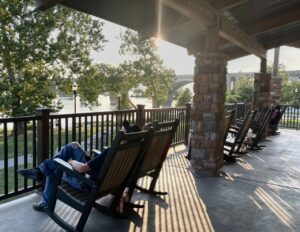
River Park is currently looking forward to development of Phase 3, covering eleven acres of land lying north of the Trail Center. Planned improvements to the 100 & 200 blocks of Walnut Street will reinforce the connection between the park and the town through an innovative design that creates a protected bicycle lane and landscape plantings while increasing street parking.
But you don’t have to wait to visit, there’s already plenty to do. You can snag a comfy rocking chair on the big deck overlooking the river, grab a tasty treat or cold one in town, check out the newly renovated Market House, or whizz past the ruins of iron furnaces as you ride upriver to Marietta and beyond. If you are in town in October, swing by for the Columbia Historic Preservation Society’s festival celebrating a staple of local lore: the Albatwitch, a mysterious creature that roams the woods surrounding town, chucking apples at unsuspecting visitors (but hopefully not you!).
 |
 |
Award Winner Spotlight: Greenways for Pittsburgh 2.0
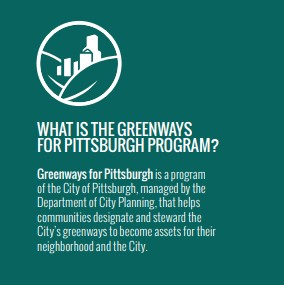 As we spotlight all things Pittsburgh in advance of the October 2021 PA APA Planning Conference, let’s revisit 2018 Annual Award Winner for Project, Program, or Practice: Greenways for Pittsburgh 2.0. The City of Pittsburgh Department of City Planning Report was produced by a consultant team led by evolve environment + architecture.
As we spotlight all things Pittsburgh in advance of the October 2021 PA APA Planning Conference, let’s revisit 2018 Annual Award Winner for Project, Program, or Practice: Greenways for Pittsburgh 2.0. The City of Pittsburgh Department of City Planning Report was produced by a consultant team led by evolve environment + architecture.
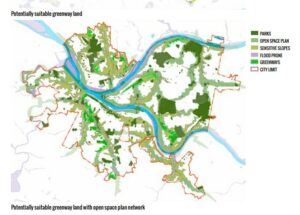 Greenways 2.0 is an initiative to reestablish and manage a greenways system in Pittsburgh. It includes a Policy Guide that sets forth the technical basis for legal designation of greenways and provides for community stewardship of greenways by citizens and non-profits in cooperation with the city. The Resource Guide provides a guide to citizens for stewarding a greenway with resources ranging from funding and project ideas to deer management options to website mockups. The Greenways 2.0 Policy Guide and Resource Guide provide the means for Pittsburgh to have more capacity and be more effective in permanently conserving open space for the benefit of adjacent neighborhoods and the general public. Learn more here!
Greenways 2.0 is an initiative to reestablish and manage a greenways system in Pittsburgh. It includes a Policy Guide that sets forth the technical basis for legal designation of greenways and provides for community stewardship of greenways by citizens and non-profits in cooperation with the city. The Resource Guide provides a guide to citizens for stewarding a greenway with resources ranging from funding and project ideas to deer management options to website mockups. The Greenways 2.0 Policy Guide and Resource Guide provide the means for Pittsburgh to have more capacity and be more effective in permanently conserving open space for the benefit of adjacent neighborhoods and the general public. Learn more here!
Delaware Water Gap National Recreation Area Visitor Use Management Plan
The Delaware Water Gap National Recreation Area is a unit of the National Park System located in Eastern Pennsylvania and Northern New Jersey. Encompassing over 69,000 acres, the park is home to Dingman’s Falls, the second highest waterfall in Pennsylvania, 27 miles of the Appalachian Trail and 40 miles of the Middle Delaware National Scenic and Recreational River.
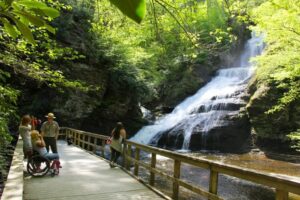 The Delaware Water Gap National Recreation Area receives over 5 million visitors annually and offers a variety of outdoor opportunities including 95 miles of trails, 216 picnic sites, 6 boat launches, 2 group campsites and 3 beaches. The park is also home to many cultural resources including 487 archeological sites covering over 500 acres. The Delaware Water Gap National Recreation Area operates year-round and provides a number of educational opportunities within the park.
The Delaware Water Gap National Recreation Area receives over 5 million visitors annually and offers a variety of outdoor opportunities including 95 miles of trails, 216 picnic sites, 6 boat launches, 2 group campsites and 3 beaches. The park is also home to many cultural resources including 487 archeological sites covering over 500 acres. The Delaware Water Gap National Recreation Area operates year-round and provides a number of educational opportunities within the park.
In 2020, the Delaware Water Gap National Recreation Area adopted its Visitor Use Management Plan. The plan was developed over a 5-year period, with collaboration and input by neighboring town governments, elected officials, partners, communities, stakeholders, researchers, NPS staff, and the public. The plan is intended to guide the park in future decision-making by maximizing the ability of the National Park Service to encourage access, improve visitor experiences and protect the natural and cultural resources of the park and the river. The plan identifies existing conditions and issues within the park and identifies goals and strategies for maintaining the integrity of the park while allowing for visitor access. To learn more online about the Visitor Use Management Plan.

